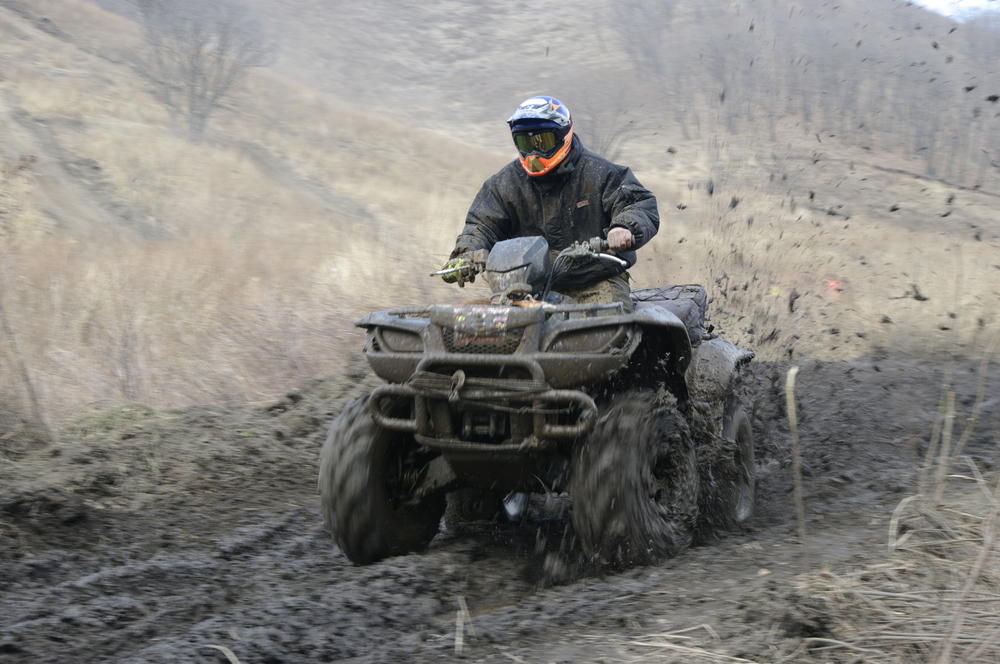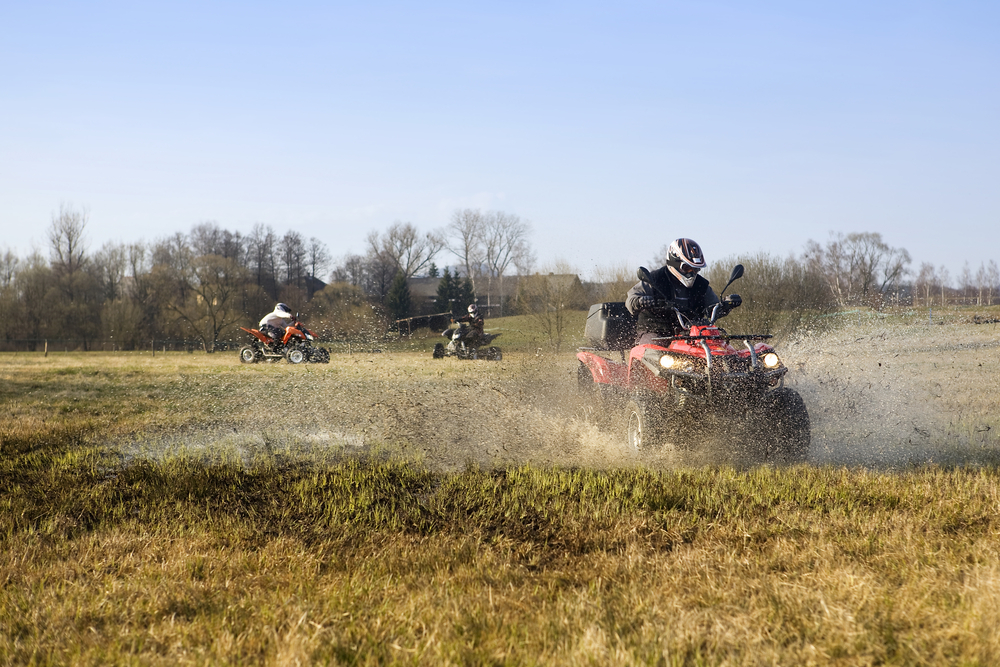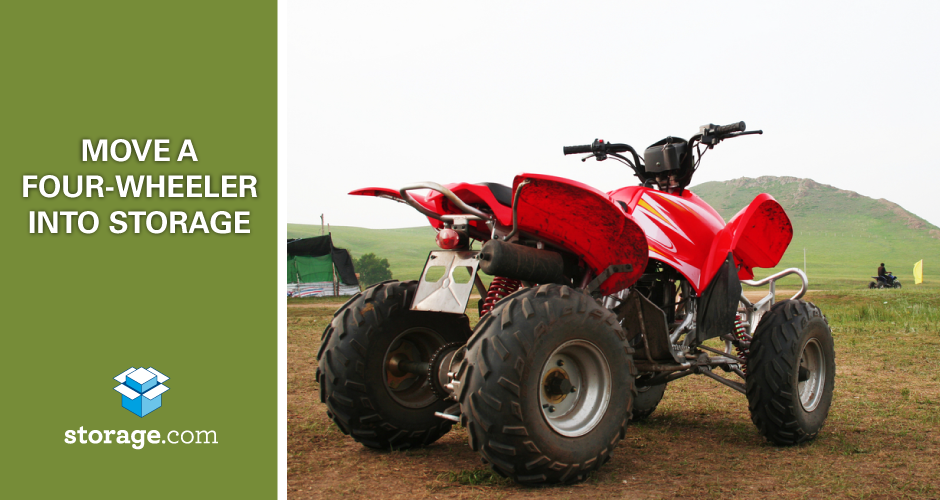
Is it time to park your four-wheeler for a while? Well, let’s make sure your off-road buddy gets a five-star treatment before it snoozes through the off-season. Just like with cars, motorcycles and boats, you need to do a bit of ATV maintenance before and during storage, to prevent damage over long periods of inactivity.
Now, here’s your one-stop guide for keeping your ATV safe, sound and ready for action next season.
1. Cleaning and Preparation
Before your ATV hibernates for the off-season, you’ll want to give it a spa day to wash away the thrill of the trails and keep the mud from becoming a permanent accessory.
- Kick things off by loosening the battlefield remnants with a gentle hose down. If the mud’s caked on like last year’s pie, use a plastic scraper to chip away at the mess without scratching your ride’s swagger.
- Crank up a pressure washer (or your trusty garden hose with a nozzle) to blast away stubborn grime and rogue engine fluids.
- Grab some bike soap or car detergent and get scrubbing. Tackle the plastics, seats, frames and wheels with a sponge or stiff brush for those hard-to-reach spots. Found some oil spots? Hit them with a degreaser, wait a bit, then send them packing.
- Whether you let the sun do its thing or grab a lint-free towel and give your ATV a thorough wipe-down, it’s essential that it be completely dry before storing it in an ATV storage unit, shed or garage.
- Finish off with a protective plastic polish to keep your ATV looking sharp and shielded, but make sure you don’t get any wax on the seat.
- Park your ATV in the sun and wait until every nook and cranny is completely dry before even thinking about parking it in a storage space.
Pro tip: An air compressor can be your secret weapon against water hiding in sneaky spots.
2. Fluids and Fuel Maintenance
Each ATV will have different steps for proper storage, especially during the cold season, depending on the engine type and the ATV’s model. “Some have carburetors, some have fuel-injection engines… It will be important to check with your owner’s manual,” says Jon Rall, ATV expert and Public Relations & Marketing Supervisor for Kawasaki, which sells ATVs, motorcycles and watercraft. “Each owner’s manual will have specific instructions for storing your ATV.”
For an engine with a carburetor, one step should always be completed before long-term storage. “Drain the fuel out of the carburetor,” says Rall. With fuel-injection engines, Rall says fuel draining isn’t required before storage, but “the owner’s manual will likely suggest a gas additive or fuel stabilizer for winter storage.”
3. ATV Battery Care
A big issue with ATV storage that you need to be aware of is that batteries tend to freeze in cold weather. After months in storage during the winter, it’s possible an ATV won’t start because of a frozen battery.
Because of this, you might look into a climate-controlled storage unit to protect your four-wheeler. However, you can save the extra bucks on this feature by removing the battery and keeping it at home instead. “You’ll want to hook up a battery tender, so it stays juiced up, or even unplug the battery,” adds Rall.
4. ATV Tire Care
If you keep those tires happy, they’ll keep rolling strong, so here’s what you can do:
- If it’s a long winter nap, pull the wheels off and stash them somewhere cool and dark, slightly deflated for a cozy rest. Leaving them on your ATV? Keep them pumped to the right pressure — check what the manufacturer recommends.
- Get those tires off the ground with a jack. This avoids pressure spots and keeps them from getting flat and grumpy. If jacking isn’t an option, just shuffle your ATV around now and then to even out the weight, and don’t stack stuff on top of it. Extra weight? Extra tire stress.
- Sunlight isn’t just tough on your skin — it speeds up tire wear, too. If your ATV is catching some rays outside, slap on UV covers to keep those tires looking young.
5. Choosing a Storage Location

If you don’t plan on using your four-wheeler for a while, having it take up valuable space in your garage or driveway is not exactly ideal. Plus, outdoor ATV storage ideas are not always feasible, depending on climate.
So, can you store an ATV in a storage unit then? Sure, this affordable option allows you to keep your all-terrain vehicle out of the way and safe from winter weather — you just need to consider a few details.
| Storage Option | Pros | Cons |
| Garage | It’s secure and protected from the elements; you have easy access whenever you need it. | It can hog valuable space you might need for other uses, especially if you have a packed garage. |
| Driveway | It’s convenient and doesn’t cost you extra. | Your ATV is exposed to weather, potential thieves and, if local ordinances are strict, could even be an eyesore. |
| Shed | It is out of sight, protected from weather and keeps your garage free for other uses. | Not as secure as a garage, and if it’s not well-built, it might still expose your ATV to some elements. |
| Storage Unit | Secure, protected from the weather and often comes with additional security like gated access and video surveillance. | Can be costly, and you’ll have to travel to the unit to pick up your ATV. Ensure the unit size fits your ATV, and check for easy access options to avoid narrow snags. |
Note: The standard storage unit size for one ATV is 5’x10’ but we strongly recommend measuring your ATV before renting a unit. You should also factor in enough room for ATV maintenance during storage.
6. Pest Prevention
Nobody wants their ATV turning into a critter condo. Here’s how to make sure pests stay away while your ride is stored:
- Critters aren’t fans of fresh scents. Mint-scented repellent packs and dryer sheets can keep mice and other pests from setting up shop in your ATV. Tuck them in corners and under the seat for a no-vacancy sign.
- Plug any open invitations like exhaust pipes and small crevices with steel wool or specially designed caps. Just remember to undo all these anti-pest arrangements before you rev up your ATV for a ride.
- Slip plastic bags over muffler outlets and other open areas. This simple trick will block out moisture and uninvited guests. Again, don’t forget to remove them when you take your ATV out.
Note: While ATV covers in the $20-$30 price range protect against dust, rain, snow and sun, they cannot keep pests at bay. For that, you will need to put your ATV in a 9’ bubble, which is less of a cover and more of an outdoor garage or storage unit. This will make your wallet roughly $500 thinner, but hey, if you’re looking for outdoor ATV storage ideas with pest control, these are the best ATV covers you could score.
7. Security Measures
Let’s make sure your ATV stays right where you left it with some clever tricks to thwart thieves:
- Use a one-two punch of a disc lock to keep the wheels from rolling and a hefty chain or U-lock to latch the frame to something sturdy like an immovable object.
- Park smart by hiding your ATV behind a bigger vehicle or sandwich it between a solid wall and your car.
- When you chain up your ATV, make sure it’s to something that can take a beating — pick a robust pole or shaft that can stand up to some tug-of-war.
- If you can swing it, setting up a security camera gives you an extra layer of defense and could help you keep tabs on your prized ride from afar.
- Install a tracking device on your ATV.
Pro tip: It might seem like a no-brainer, but… always take the keys with you.
8. Regular Check-ups
Regular peeks under the hood (or seat, in this case) can save you a lot of trouble. Keep an eye out for leaks, loose parts or any signs of wear. Pay extra attention to tires, as they can be sneaky and lose air, especially when it’s cold. Check the pressure regularly — perfectly pumped tires mean a smoother ride and less stress on your ATV.
9. Post-Storage Inspection
Before hitting the trails again, give your ATV a thorough check:
- Make sure the battery hasn’t decided to take a permanent vacation. Charge it up if needed, and look for any signs of wear or corrosion on the connections.
- Check and top off all fluids — oil, coolant, brake fluid.
- As we mentioned a couple of times already, tires can lose pressure while sitting idle, so check them for the right inflation. Make sure there are no cracks or flat spots.
- Brake pads can last for years, but rough riding conditions may mean they need to be replaced more often. Always check that the brake pads aren’t worn down — this is a non-negotiable before every ride!
- Flip on all the lights to make sure they’re still working. Replace any bulbs that have burnt out.
Pro tip: Before you go full throttle, take your ATV for a slow test ride to listen for any unusual noises or rough idling that might suggest issues.
Choose Secure ATV Storage Solutions
Armed with these ATV storage tips, you’re set to extend the life of your four-wheeler and enhance its performance for many rides to come. Invest a little time now and research ATV storage locations, clean up your ride buddy, prep it and enjoy a lot of trouble-free, mud-slinging fun later.
Watch the video: How to Store an ATV
Blog in :30 | How to Store an ATV from Storage.com on Vimeo.





![Relocating RVs: An Expert Guide to Finding RV Relocation Deals and Cheap Motorhomes for Rent [2025]](https://blog.storage.com/wp-content/uploads/2025/03/rv-relo.jpg)
